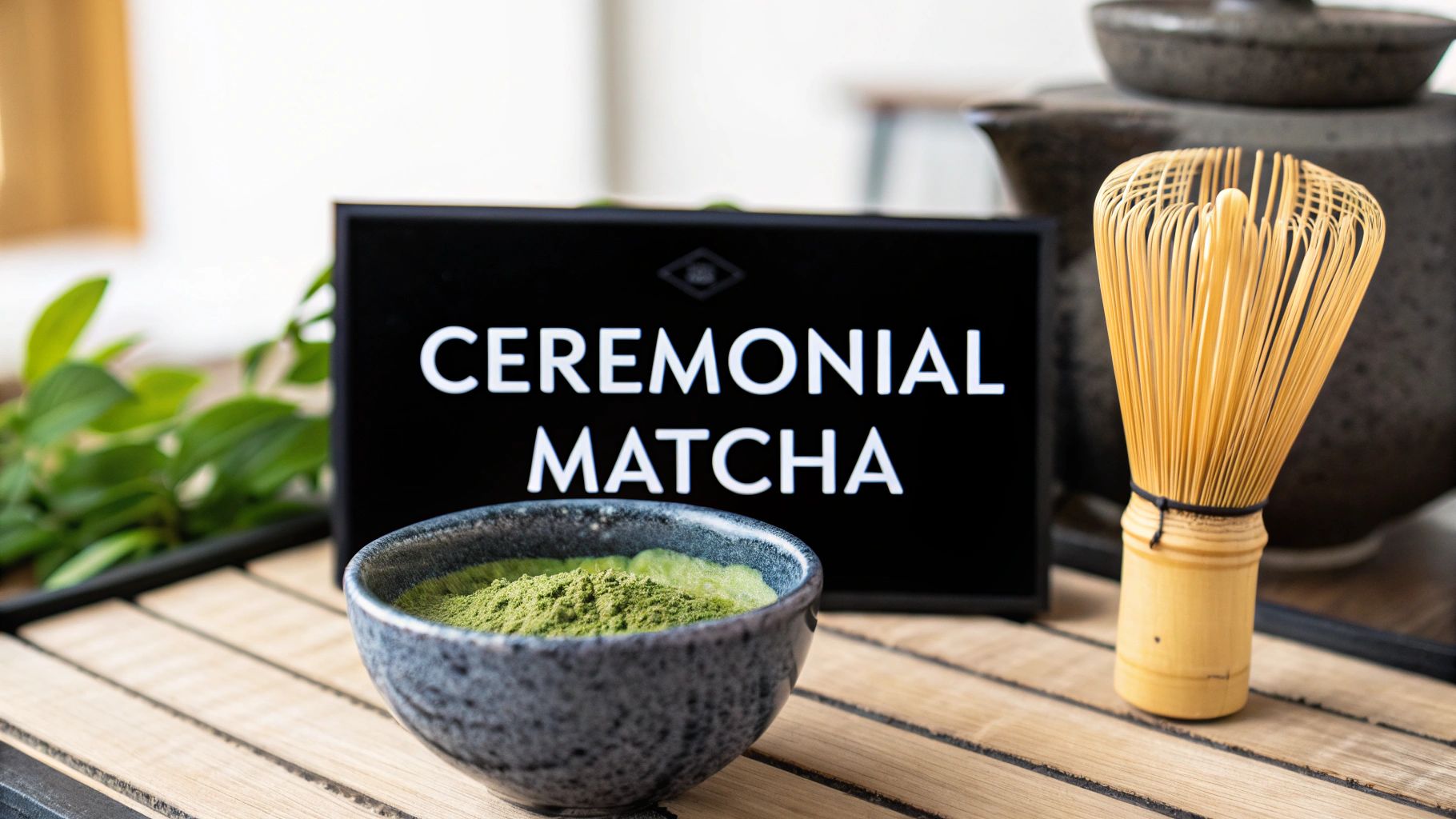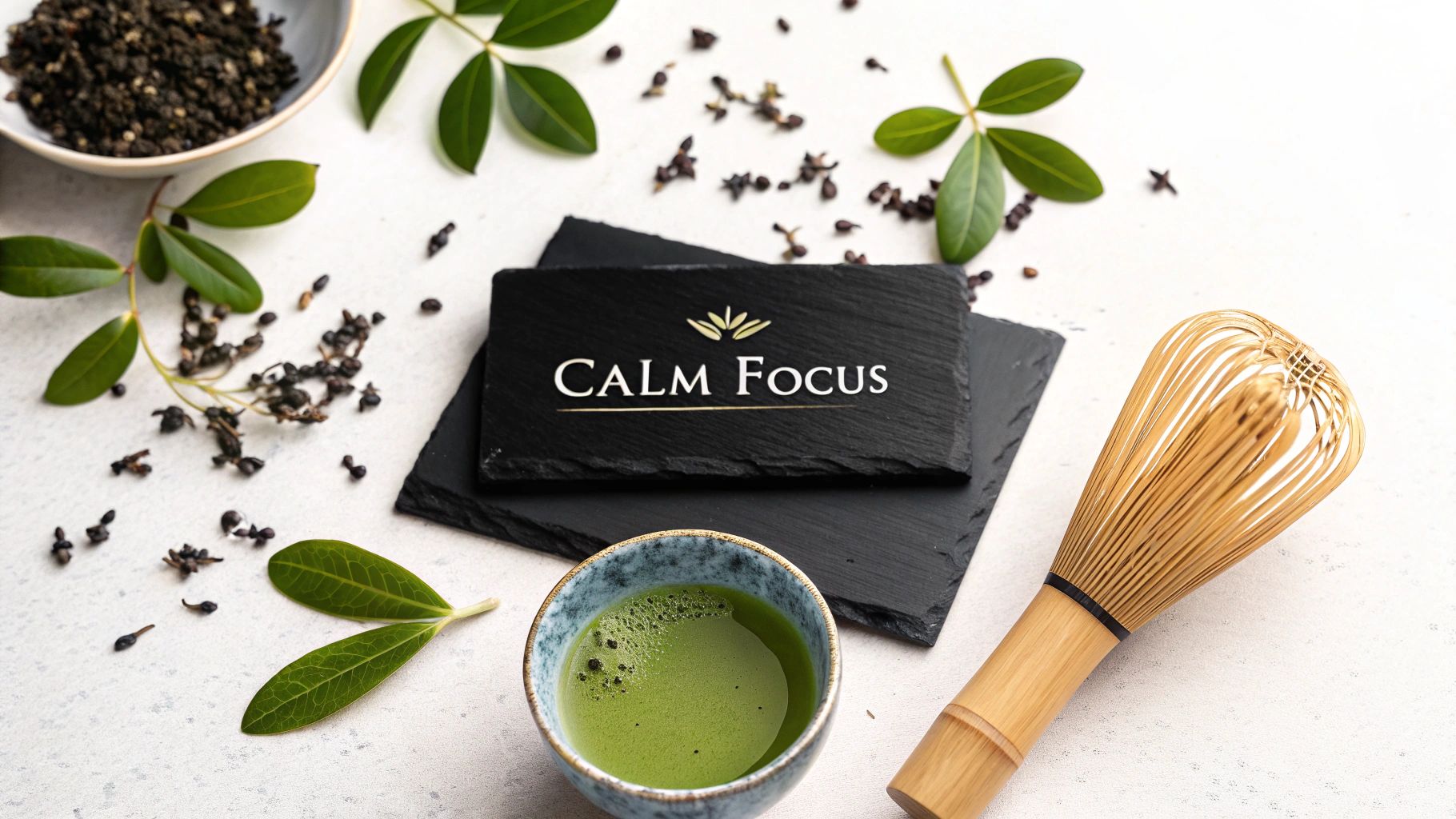Ceremonial matcha green tea powder isn't just any green tea. It's the absolute pinnacle of quality, traditionally stone-ground into an impossibly fine powder reserved for the meticulous art of the Japanese tea ceremony. Its signature vibrant jade-green colour, silky texture, and a uniquely delicate, umami-rich flavour all come from one crucial step: using only the youngest, shade-grown tea leaves. This careful process supercharges the leaves with chlorophyll and L-theanine, setting it worlds apart from lower grades.
The Essence of Ceremonial Grade Matcha
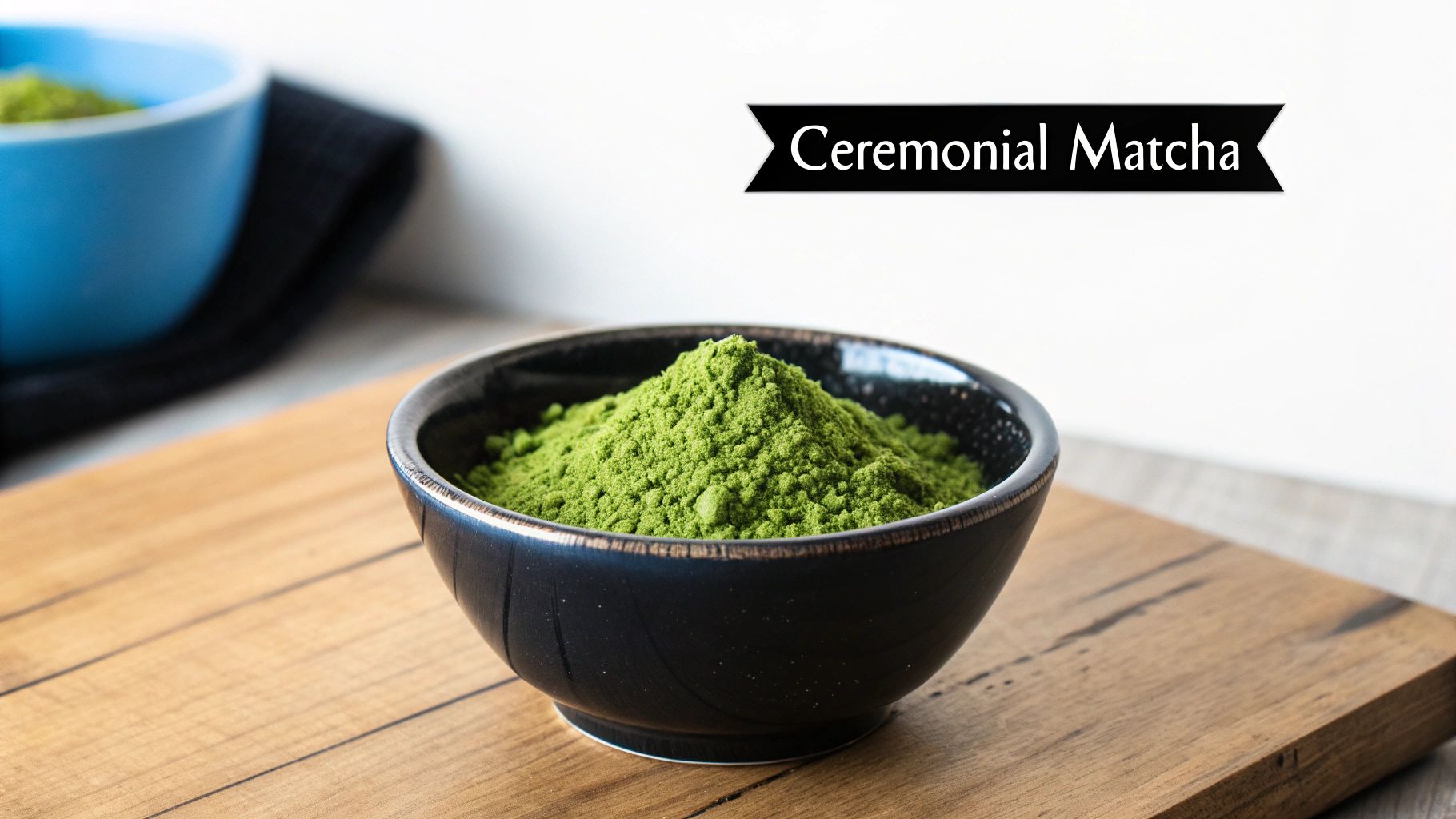
Picture the most nutrient-packed green tea you can imagine, grown with incredible attention to detail and then transformed into a powder so fine it melts into a creamy, frothy elixir. That’s the real spirit of ceremonial matcha. It’s far more than a simple drink; it’s an experience designed for moments of calm and focused energy—a feeling you can discover with every scoop of Amatsu Matcha's Pure Ceremonial Grade.
The journey to this exceptional quality starts in the tea fields, well before the leaves are even picked. For about 20-30 days, the tea plants are carefully shaded from direct sunlight. This simple-sounding step works wonders on the leaf's chemistry, forcing it to produce more chlorophyll—giving it that stunning green hue—and the calming amino acid, L-theanine.
What Defines True Ceremonial Quality
The word "ceremonial" isn't just clever marketing; it’s a promise of quality directly linked to its traditional role in chanoyu, the Japanese tea ceremony. Once you know what to look for, its characteristics are unmistakable.
Here’s what sets it apart:
- Vibrant Colour: The first giveaway is a brilliant, almost electric, jade green. If it looks dull or yellowish, you’re looking at a lower-grade powder.
- Silky Texture: True ceremonial matcha should feel incredibly fine and smooth when you rub it between your fingers, almost like eyeshadow.
- Delicate Flavour: The taste is a symphony of subtle sweetness and deep umami notes, finishing with a smooth, mellow character completely lacking the bitterness you find in culinary grades.
- Rich Froth: When you whisk it properly, it should create a thick, creamy layer of foam on top—a true hallmark of its fine grind and high quality.
At its heart, ceremonial matcha is an invitation to pause. The process of preparing it is just as important as the drink itself—a mindful ritual that calms the mind and centres the spirit.
Distinguishing It from Other Grades
Getting to grips with the difference between ceremonial and culinary matcha is key to truly appreciating its value. Culinary matcha is fantastic for adding a green tea kick to lattes, smoothies, and cakes. Its bolder, more astringent flavour is specifically designed to cut through other ingredients.
Ceremonial grade, however, is meant to be enjoyed pure and simple, prepared with just hot water. Its delicate and complex flavour profile would be completely lost if you added milk or sugar. If you’re curious to learn more, our detailed guide on the different matcha tea grades is the perfect place to start. This knowledge will help you choose the right matcha for the right moment, making every sip an exceptional one.
Where Matcha's Story Begins
To really get to the heart of what makes ceremonial matcha so special, you have to travel back in time. And surprisingly, the story doesn't start in Japan. It actually begins in Tang Dynasty China, where tea leaves were steamed and pressed into solid bricks to make them easier to transport and trade. It wasn't until the Song Dynasty (960-1279) that the practice of grinding the tea into a fine powder and whisking it with hot water really took off and became a cherished ritual.
This unique way of preparing tea found its way to Japan in 1191, carried by a Zen Buddhist monk named Eisai. He didn't just bring back tea seeds; he brought back the entire philosophy of powdered tea. Eisai quickly realised that drinking this tea helped create a state of calm focus—perfect for long hours of meditation.
From there, the art of cultivating and preparing powdered tea was honed within the serene walls of Japan's Zen temples. The monks became masters of the craft, discovering that shading the tea plants for a few weeks before harvest resulted in leaves that were sweeter, a more brilliant green, and packed with more nutrients. This very discovery laid the groundwork for the exceptional matcha we enjoy today.
Uji, Japan: The Cradle of Excellence
When you talk about the world's best matcha, you're really talking about Uji. It's a small city just outside Kyoto, and it's considered the absolute heartland of quality matcha. The terroir there is simply perfect—the soil is rich, the air is misty, and the temperatures are just right for growing incredible tea. For centuries, the tea farmers of Uji have passed down their meticulous methods, from covering the plants with traditional straw mats to hand-picking only the youngest, most tender leaves.
This unwavering dedication has made the name Uji synonymous with the finest ceremonial matcha green tea powder on the planet. The region's legacy is so powerful that most of the world's most prized matcha, including the leaves sourced for Amatsu Matcha, still comes from its fields. Knowing about Uji is the first step in understanding the vast difference between a standard green tea and a truly authentic matcha tea from Japan.
"The Japanese tea ceremony, or 'chanoyu,' is not about drinking tea, but about appreciating a moment of peace and presence. Matcha is the heart of this practice, a medium through which harmony, respect, purity, and tranquillity are expressed."
The Art of the Tea Ceremony
Matcha didn’t stay just a monk’s beverage for long. It quickly became the centrepiece of the Japanese tea ceremony, known as chanoyu or sadō (The Way of Tea). Tea masters like the legendary Sen no Rikyū in the 16th century refined the practice, turning the simple act of preparing tea into a deeply spiritual discipline. Every single gesture, from wiping the bowl to whisking the tea, is performed with intention and grace.
The ceremony is guided by four core principles:
- Wa (Harmony): Cultivating a connection with nature and the people you are with.
- Kei (Respect): Showing genuine reverence for guests, the tea utensils, and the tea itself.
- Sei (Purity): This refers to both the physical cleanliness of the space and the clarity of one's own mind.
- Jaku (Tranquillity): The profound sense of inner calm that comes from living the other three principles.
This rich tradition is exactly why ceremonial grade matcha is held in such high regard. It was never just a drink; it was a tool for a mindful, artistic, and spiritual practice. That same reverence for quality lives on, though global demand sometimes puts a strain on the incredibly labour-intensive production. For instance, in 2025, the UK experienced a significant shortage of ceremonial matcha. Extreme weather hit key growing areas like Uji, slashing yields right as British consumer interest was booming. This led to sharp price increases and showed just how fragile the balance is between ancient farming and modern demand.
Unlocking the Health Benefits of Ceremonial Matcha
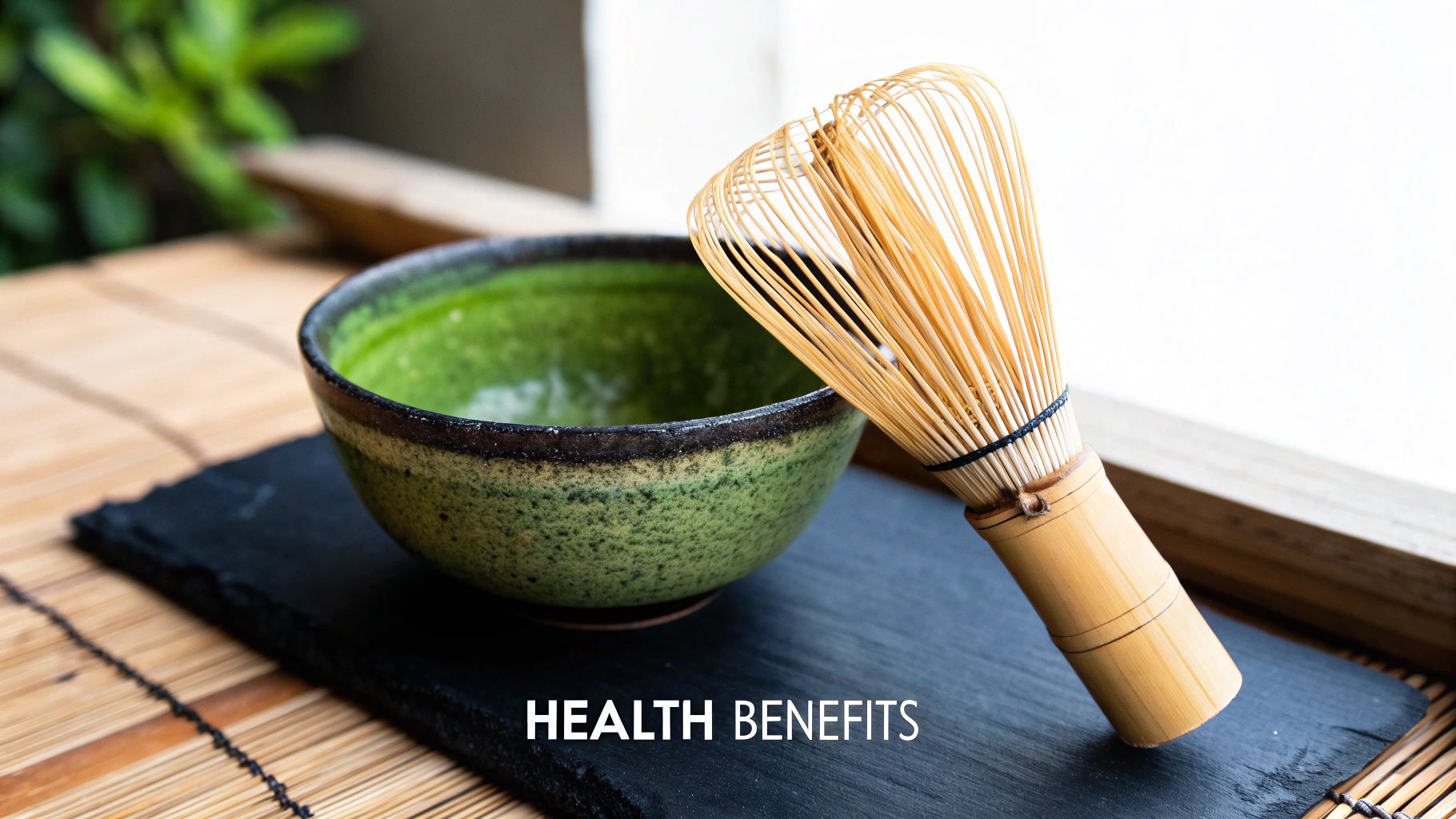
Beyond its deep cultural roots and exquisite flavour, ceremonial matcha is a genuine powerhouse of wellness benefits. Each vibrant green bowl offers a unique blend of natural compounds that work in harmony to support both body and mind, making it so much more than a simple cup of tea.
The secret to matcha's potency is all in the preparation. Because you consume the entire tea leaf—ground into a fine powder—you receive 100% of its nutrients. It’s a world away from steeped green tea, where many of those valuable benefits are simply thrown away with the leaves. This whole-leaf method delivers a truly concentrated dose of vitamins, minerals, and powerful plant compounds.
This concentration of goodness is why matcha has found its place at the heart of modern wellness routines. The growing awareness of these benefits is clear to see in its soaring popularity. In fact, the UK matcha tea market was valued at approximately USD 340 million in 2025 and is projected to climb to around USD 790 million by 2031. It’s a real testament to the rising demand for drinks that are both functional and health-conscious.
The Power of L-Theanine: Calm Alertness
Ever felt that sharp spike and sudden crash from a strong cup of coffee? Matcha offers a beautifully different experience, and it's all thanks to a remarkable amino acid called L-theanine.
L-theanine is found in abundance in shade-grown tea leaves and is the key to matcha’s signature feeling of calm, focused alertness. It works by encouraging the production of alpha brain waves, which are linked to a state of relaxed wakefulness—much like the feeling you get during meditation.
This unique compound also moderates the effects of caffeine, slowing its absorption into the bloodstream. The result? A gentle lift in energy that can last for 3-6 hours, giving you sustained mental clarity and concentration without any of the jitters or anxiety that caffeine can sometimes trigger. Think of it as a smooth, steady wave of focus, not a sudden jolt.
The synergy between L-theanine and caffeine is what makes matcha so special. It sharpens the mind while calming the spirit, creating an ideal state for productivity, creativity, or simply being present in the moment.
A Rich Source of Antioxidants
Ceremonial matcha is packed with a class of powerful antioxidants known as catechins. The most famous of these is Epigallocatechin Gallate (EGCG), which is found in concentrations up to 137 times greater in matcha than in standard brewed green tea.
So, why does that matter? Well, antioxidants are vital for our cellular health. They act like bodyguards, neutralising harmful free radicals in the body. Free radicals are unstable molecules that cause oxidative stress, a process linked to cellular damage and ageing.
By making a daily bowl of matcha part of your routine, you’re equipping your body with a potent defence system.
- Cellular Protection: EGCG helps shield your cells from the damaging effects of oxidative stress.
- Metabolic Support: Some studies suggest the catechins in matcha can gently support a healthy metabolism.
- Overall Vitality: A diet rich in antioxidants is a cornerstone of overall well-being and vitality.
This incredible combination of calm-inducing L-theanine and protective EGCG is what makes ceremonial matcha a truly functional drink. It doesn’t just give you a boost of energy; it provides a mindful, nourishing experience that supports you from the inside out. For a more comprehensive look at these advantages, you can learn more about the full spectrum of matcha's health benefits in our detailed article.
How to Choose High-Quality Ceremonial Matcha
Stepping into the world of matcha can feel a bit overwhelming, with tins of green powder all claiming to be the best. But here’s the thing: not all matcha is created equal. Choosing a proper ceremonial matcha green tea powder is the difference between a bitter, grainy drink and a smooth, vibrant, and uplifting experience.
Learning to spot the real deal is simpler than you might think. It’s a sensory journey that involves your eyes, nose, and even your sense of touch. Once you know what to look for, you'll be able to select an authentic ceremonial matcha with confidence, ensuring every bowl is a moment of pure enjoyment.
The Significance of Colour
Your very first clue to exceptional quality is the colour. True ceremonial grade matcha should have a brilliant, almost electric, jade-green hue. This isn't just for show; it's a direct result of the meticulous shade-growing process that real matcha undergoes.
When tea leaves are shielded from the sun for weeks before harvest, they are forced to produce more chlorophyll. This abundance of chlorophyll is what gives the leaves their stunning colour and also packs them with nutrients.
- What to Look For: An intense, deep, and vibrant green.
- What to Avoid: A dull, swampy, or yellowish-brown powder. This often indicates lower-quality leaves, a later harvest, or that the powder has oxidised from poor storage.
Think of it like choosing fresh spinach over wilted leaves; the vibrancy is a clear sign of vitality and freshness.
Aroma and Texture Unveiled
Beyond its colour, your other senses play a vital role. When you open a tin of high-quality matcha, you should be greeted by a fresh, sweet, and vegetal aroma. You might pick up subtle notes of fresh grass, sweet peas, and even a hint of nutty sweetness. A bitter or dusty smell is a definite red flag.
Next, feel the texture. High-quality ceremonial matcha is stone-ground into an incredibly fine powder, with particles measuring just a few microns in size.
When you rub a small amount between your fingers, it should feel as silky and smooth as talc or eyeshadow. Any grittiness is a sign that it wasn’t ground properly or may contain stems and veins, which are removed in the highest grades.
This ultra-fine texture is crucial for creating a smooth, creamy bowl without any clumps. It’s what allows the powder to suspend perfectly in water, creating that signature rich froth. This is precisely why blends like Amatsu's Pure Ceremonial Grade are so effortless to whisk; their stone-ground fineness guarantees a flawless, velvety consistency every time.
The Importance of Origin and Harvest
Where your matcha comes from matters immensely. The undisputed home of the finest ceremonial matcha is Uji, Japan. The unique terroir of this region—its rich soil, misty climate, and generations of farming expertise—creates the perfect conditions for growing exceptional tea. Always check the packaging for a specific origin, as authentic Japanese matcha is a hallmark of quality.
Equally important is the harvest. The most prized matcha comes exclusively from the first harvest, known as Ichibancha. These are the youngest, most tender leaves that sprout in the spring, and they contain the highest concentration of L-theanine and umami flavour. Later harvests produce leaves that are more bitter and are typically used for culinary grade matcha.
Investing in a ceremonial matcha from a reputable origin like Uji ensures you're getting a product steeped in tradition and quality. If you're wondering where to begin your search, our guide on where to buy matcha tea powder offers some excellent starting points.
Your Guide to Brewing the Perfect Bowl of Matcha
There’s a real art to preparing ceremonial matcha, but it's a ritual that’s much simpler to master than you might think. Getting it right is about more than just making a drink; it's a mindful practice that connects you to a rich history. Let's walk through the traditional whisking method so you can create a perfect, frothy bowl of matcha every single time.
The secret to a flawless bowl isn’t complicated. It comes down to having the right tools and a little bit of technique. Once you get the hang of it, you’ll find the preparation can become a peaceful, centring part of your daily routine.
Assembling Your Essential Tools
To do it the traditional way, you only need a few key items. These aren't just for show; each tool has been refined over centuries to bring out the very best in the tea, ensuring you get a beautifully aerated, lump-free drink.
Here’s what you’ll need:
- A Matcha Bowl (Chawan): A wide, flat-bottomed bowl really is best. The shape gives you plenty of room to whisk properly without making a mess and helps that lovely foam form on top.
- A Bamboo Whisk (Chasen): This is your most important tool. A good chasen has 80-120 delicate tines designed specifically to break up the fine matcha powder and whip air into the tea, creating its signature creamy froth.
- A Bamboo Scoop (Chashaku): You could use a teaspoon, of course, but the chashaku is shaped to measure out the perfect amount for one serving—usually about 1-2 scoops.
While these tools are part of the tradition, it helps that Amatsu Matcha's ceremonial powder is incredibly forgiving. Its silky texture is stone-ground to resist clumping, making it much easier for even a beginner to achieve a perfectly smooth finish.
The Step-by-Step Brewing Ritual
With your tools laid out, the process itself is surprisingly quick and almost meditative. The whole point is to suspend the fine tea particles evenly in the water while creating a delicate layer of foam. This is how you unlock the full flavour and creamy body of high-quality ceremonial matcha.
This quick infographic shows the incredible journey from a fresh tea leaf to the vibrant powder in your bowl.
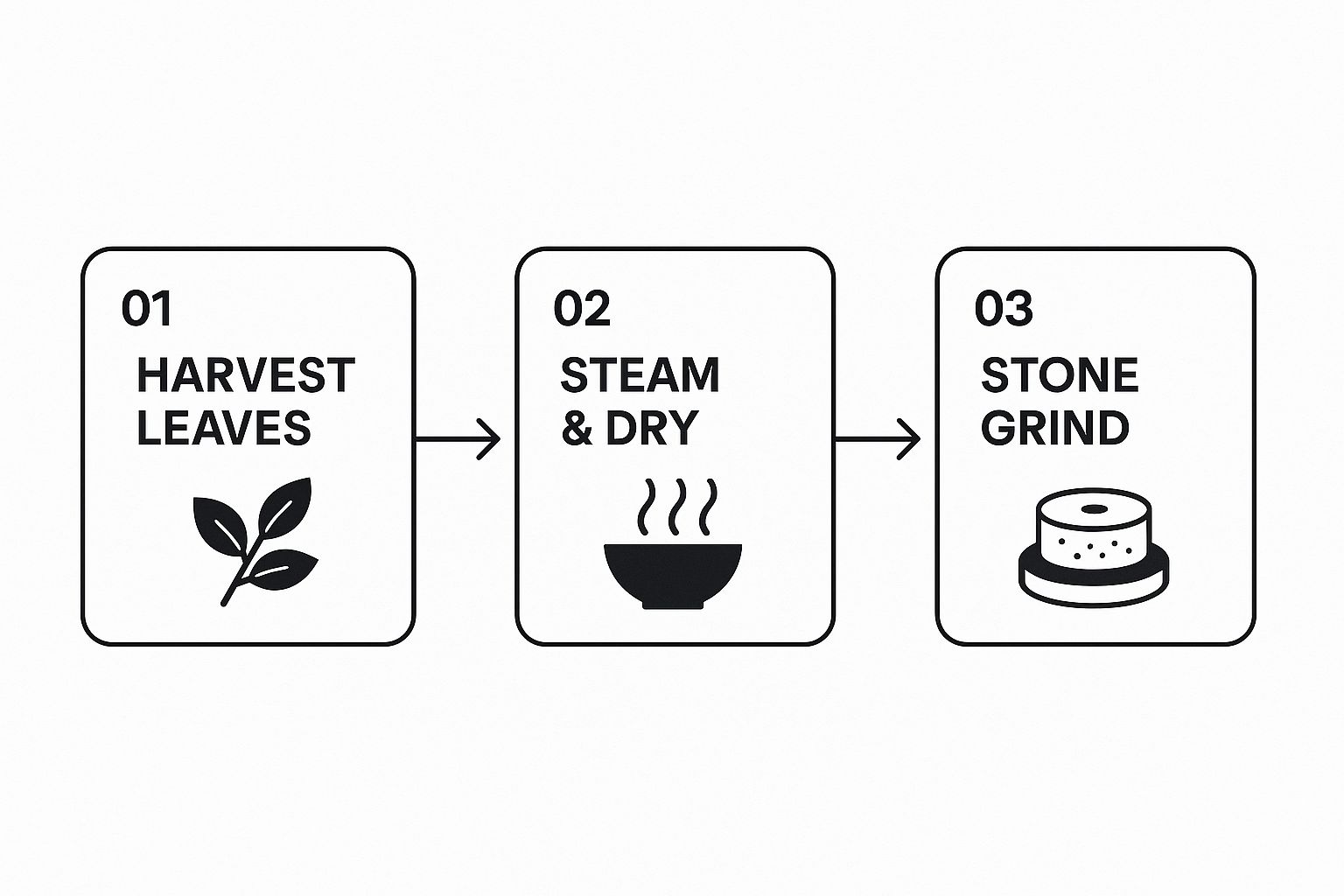
It’s a great reminder of the meticulous harvesting, steaming, and stone-grinding that goes into producing this incredible powder.
1. Sift the Matcha: First things first, sift 1-2 grams (that's about 1 teaspoon or 2 chashaku scoops) of matcha through a small, fine-meshed sieve directly into your chawan. Don't skip this! It's the most important step for getting rid of any tiny clumps and guaranteeing a silky-smooth tea.
2. Add Hot Water: Next, pour in about 60-80 ml of hot water. The key here is hot, not boiling. The ideal temperature is around 80°C (175°F). If the water is too hot, it can easily scorch the delicate powder and leave you with a bitter taste.
3. Whisk Vigorously: This is where the magic happens. Hold the bowl firmly with one hand and use the other to whisk the matcha with your chasen. You're not stirring in circles—instead, use a quick, zig-zagging 'W' or 'M' motion, making sure the tines gently scrape the bottom of the bowl.
4. Create the Froth: Keep whisking for about 20-30 seconds. You’ll see the tea become completely smooth as a thick layer of fine, jade-green foam forms across the surface. What you're aiming for is a creamy froth made of tiny, uniform bubbles.
The perfect bowl of matcha has a smooth, consistent body with no clumps of powder left behind, all topped by a rich layer of foam. This 'crema' is the hallmark of high-quality matcha and a sign you've nailed the technique.
And that's it! Your matcha is ready to be enjoyed right away. Take a moment to savour its complex umami flavour and the calm, focused energy it brings. If you want to dive deeper into the technique, be sure to check out our complete guide on how to whisk matcha for more tips and tricks.
Integrating Matcha Into Your Modern Lifestyle
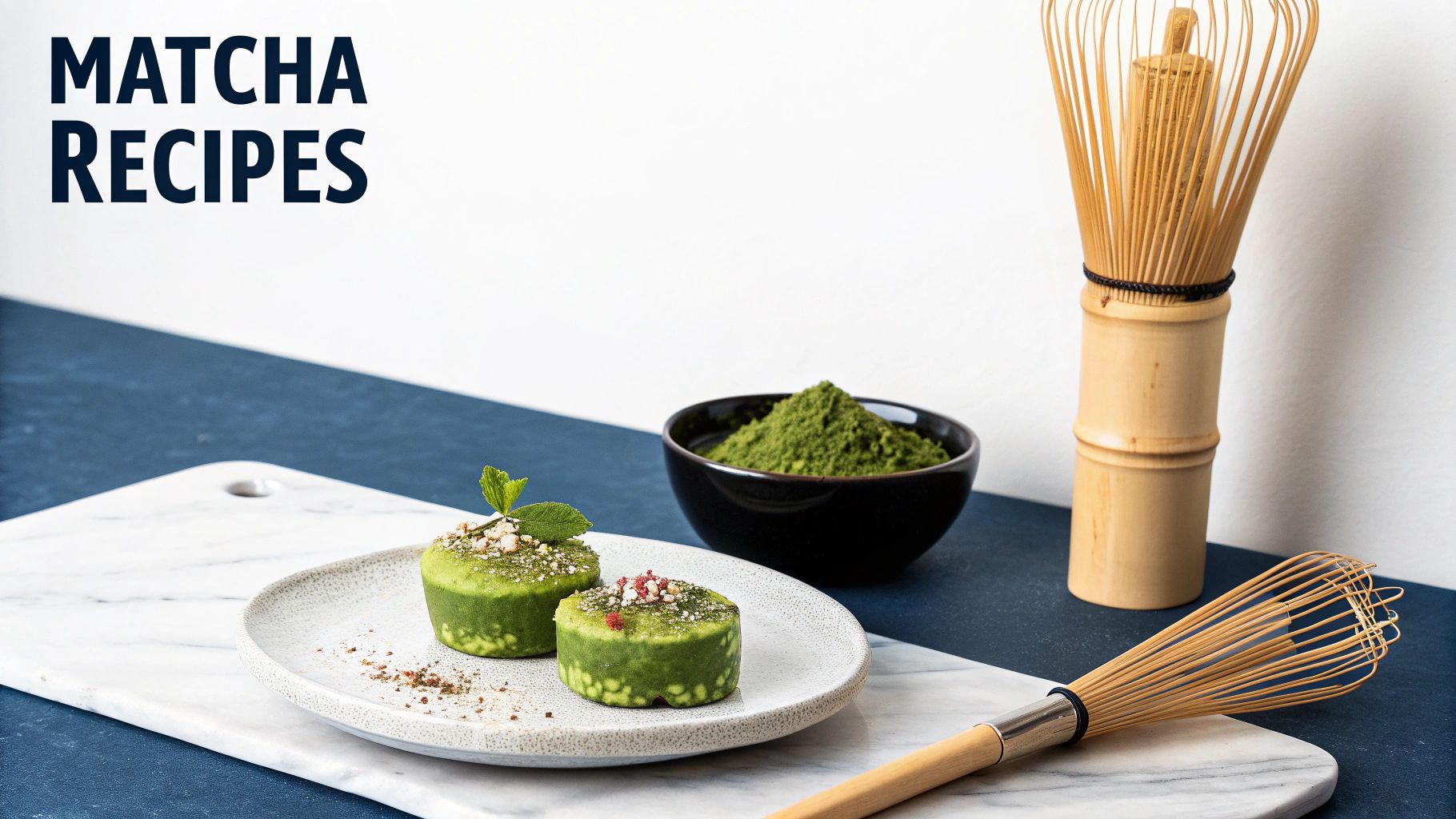
While the traditional Japanese tea ceremony is a beautiful, mindful practice, you don’t need a formal ritual to enjoy the incredible benefits of ceremonial matcha. It's surprisingly easy to weave this vibrant green tea powder into your daily rhythm, turning ordinary moments into pockets of wellness.
The delicate, umami-rich flavour of ceremonial grade matcha is wonderfully versatile, as long as you let its subtleties shine. Think beyond just a traditional bowl; imagine kick-starting your day with a nutrient-packed smoothie or a creamy, gently energising wellness latte. This is how you bring its unique gift of calm, focused energy into your routine without any fuss.
This shift towards high-quality, health-conscious teas is becoming more common. Here in the UK, while a classic cuppa of black tea is still king, speciality teas like matcha are carving out a serious space for themselves. The UK’s tea market bounced back in a big way in 2024, with import values jumping 21.57% to almost USD 377 million. This growth is really being pushed by people wanting premium, top-tier products like ceremonial matcha. You can read more about UK tea market trends and this impressive growth.
Functional Blends for Targeted Goals
For anyone looking to get even more out of their daily cup, functional matcha blends are the perfect solution. Amatsu Matcha, for instance, has developed some brilliant formulas that pair our premium ceremonial matcha with other powerful, clean ingredients to help you meet specific goals.
Here are a couple of examples:
-
Amatsu Shrooms: This one is all about sharpening your mind. It combines the clear focus you get from matcha with adaptogenic mushrooms like Lion's Mane and Cordyceps. The synergy between them is incredible for supporting mental clarity and cognitive performance.
-
Amatsu Strength: Designed with physical performance and recovery in mind, this blend mixes matcha with creatine. It makes for an ideal pre- or post-workout drink, giving you that sustained energy from the L-theanine while helping with muscle endurance and repair.
Choosing a functional blend turns your daily drink from a simple pleasure into a purposeful ritual. It’s a smart way to match your matcha moment with whatever you're trying to achieve—whether that’s a sharper focus for work or better physical resilience. This modern take makes the ancient tradition of matcha more relevant and beneficial than ever.
Your Ceremonial Matcha Questions, Answered
Diving into the world of ceremonial matcha can feel a bit like learning a new language. It's totally normal to have questions! Getting them answered is the best way to feel confident and make sure every bowl you prepare is a moment of pure enjoyment. Let's tackle some of the most common ones we get asked.
Think of this as your personal guide. The more you understand these little details, the more you'll appreciate what makes this tea so special and how it can fit beautifully into your daily routine.
How Much Caffeine Is in Ceremonial Matcha?
A typical serving of ceremonial matcha (about one gram) has somewhere between 35-70 mg of caffeine. Now, that's less than your average coffee, but the way your body experiences it is a world apart.
The secret lies in an amazing amino acid called L-theanine, which is abundant in high-quality matcha. It partners with the caffeine, creating a gentle, sustained energy release that can last for three to six hours. This gives you a unique feeling of 'calm alertness' – all the focus, but without the jittery spike and dreaded crash you often get from coffee.
Can I Use Ceremonial Grade Matcha for Lattes or Baking?
You could, but we wouldn't recommend it. The beauty of ceremonial grade matcha is its delicate, nuanced flavour. Those subtle sweet and umami notes are precisely what you're paying for, and they're best enjoyed simply with hot water. Mix it with milk, sugar, or other bold ingredients, and that special character gets completely lost.
For things like lattes, smoothies, or baking, you're much better off reaching for a good culinary grade matcha. It has a stronger, more assertive flavour designed specifically to hold its own against other ingredients, and it's kinder to your wallet too.
How Should I Store My Ceremonial Matcha Powder?
This is a big one! Proper storage is absolutely key to keeping your matcha at its best. To protect its brilliant green colour, delicate taste, and all those wonderful nutrients, always keep it in an airtight container.
The fridge is its best friend. Light, heat, and air are the three enemies of fresh matcha; they'll degrade its quality faster than you can say "umami." To get the most out of your purchase, try to enjoy your matcha within a few months of opening it.
Is Ceremonial Matcha Worth the Higher Price?
Without a doubt, yes—especially if you want to experience matcha in its purest, most traditional form. That higher price tag is a direct reflection of the incredible amount of care and meticulous labour that goes into producing it.
We're talking about using only the youngest, most tender leaves from the very first harvest of the year, grown under special shade cloths. These precious leaves are then slowly and carefully stone-ground into a powder as fine as talc. This whole process is what gives our Pure Ceremonial Grade matcha its smooth, creamy taste and a higher concentration of beneficial goodies like L-theanine and antioxidants. It's truly an investment in your well-being.
Ready to feel the pure, calming energy of authentic ceremonial matcha for yourself? Take a look at the Amatsu Matcha collection and find the perfect blend to elevate your daily ritual. Your new source of focus and vitality is waiting.
